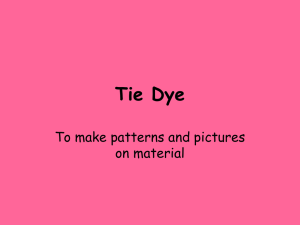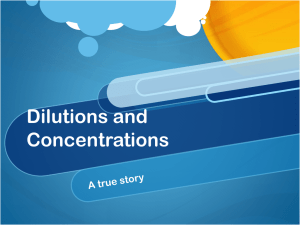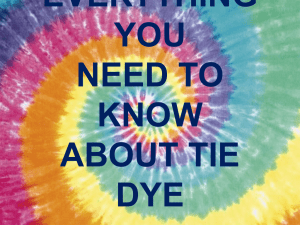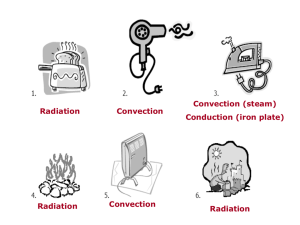How to Tie Dye
advertisement
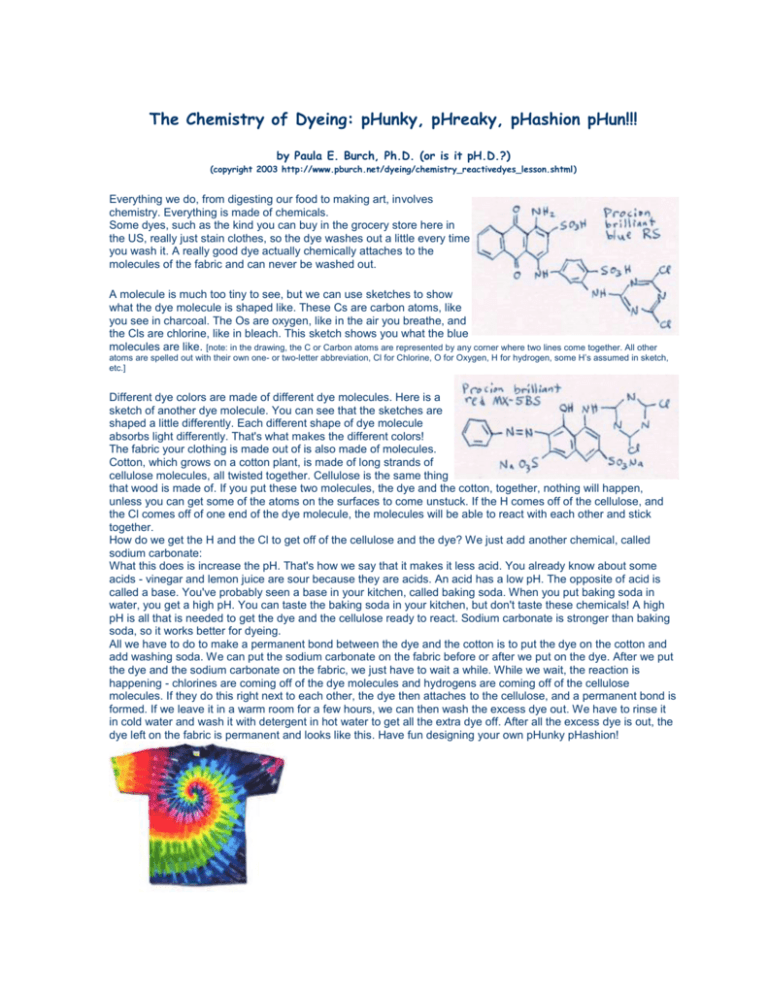
The Chemistry of Dyeing: pHunky, pHreaky, pHashion pHun!!! by Paula E. Burch, Ph.D. (or is it pH.D.?) (copyright 2003 http://www.pburch.net/dyeing/chemistry_reactivedyes_lesson.shtml) Everything we do, from digesting our food to making art, involves chemistry. Everything is made of chemicals. Some dyes, such as the kind you can buy in the grocery store here in the US, really just stain clothes, so the dye washes out a little every time you wash it. A really good dye actually chemically attaches to the molecules of the fabric and can never be washed out. A molecule is much too tiny to see, but we can use sketches to show what the dye molecule is shaped like. These Cs are carbon atoms, like you see in charcoal. The Os are oxygen, like in the air you breathe, and the Cls are chlorine, like in bleach. This sketch shows you what the blue molecules are like. [note: in the drawing, the C or Carbon atoms are represented by any corner where two lines come together. All other atoms are spelled out with their own one- or two-letter abbreviation, Cl for Chlorine, O for Oxygen, H for hydrogen, some H’s assumed in sketch, etc.] Different dye colors are made of different dye molecules. Here is a sketch of another dye molecule. You can see that the sketches are shaped a little differently. Each different shape of dye molecule absorbs light differently. That's what makes the different colors! The fabric your clothing is made out of is also made of molecules. Cotton, which grows on a cotton plant, is made of long strands of cellulose molecules, all twisted together. Cellulose is the same thing that wood is made of. If you put these two molecules, the dye and the cotton, together, nothing will happen, unless you can get some of the atoms on the surfaces to come unstuck. If the H comes off of the cellulose, and the Cl comes off of one end of the dye molecule, the molecules will be able to react with each other and stick together. How do we get the H and the Cl to get off of the cellulose and the dye? We just add another chemical, called sodium carbonate: What this does is increase the pH. That's how we say that it makes it less acid. You already know about some acids - vinegar and lemon juice are sour because they are acids. An acid has a low pH. The opposite of acid is called a base. You've probably seen a base in your kitchen, called baking soda. When you put baking soda in water, you get a high pH. You can taste the baking soda in your kitchen, but don't taste these chemicals! A high pH is all that is needed to get the dye and the cellulose ready to react. Sodium carbonate is stronger than baking soda, so it works better for dyeing. All we have to do to make a permanent bond between the dye and the cotton is to put the dye on the cotton and add washing soda. We can put the sodium carbonate on the fabric before or after we put on the dye. After we put the dye and the sodium carbonate on the fabric, we just have to wait a while. While we wait, the reaction is happening - chlorines are coming off of the dye molecules and hydrogens are coming off of the cellulose molecules. If they do this right next to each other, the dye then attaches to the cellulose, and a permanent bond is formed. If we leave it in a warm room for a few hours, we can then wash the excess dye out. We have to rinse it in cold water and wash it with detergent in hot water to get all the extra dye off. After all the excess dye is out, the dye left on the fabric is permanent and looks like this. Have fun designing your own pHunky pHashion! How to Tie Dye Use fiber reactive dye for tie-dyeing. Do not use all-purpose dye! Getting Started Be sure to pre-wash all clothing to remove invisible finishes that can prevent the dye from getting to the fabric. Why Tie? The whole point of tie dyeing is to prevent the dye from reaching the fabric evenly. Any place that the dye can't reach will stay white, or a lighter color, of course. The gradations of color from intense to light can be beautiful. You can accomplish this by folding the fabric, tieing it with string, using rubber bands, etc. Another reason to tie is that it makes each garment of piece of cloth a small, neat bundle--much easier to handle if you have a lot to do. If you don't tie, but just apply the dye directly, you need more space and can do fewer garments or pieces of fabric at a time. Ways to Tie Fold a piece of clothing in vertical pleats, and you'll end up with horizontal stripes. Horizontal pleats result in vertical stripes (more slimming, you know). Diagonal pleats make a nice effect. Stitch a loose basting stitch in any shape you like, then pull the threads tight for another form of tie-dyeing that can have really cool results. For concentric circles, grab the cloth where you want the center to be, and pull, until you've more or less made a long tube of the garment, then apply rubber bands at intervals along the fabric. I also like the "scrunch" pattern, made by crumpling the fabric very evenly, so that ultimately it makes a nice flat disk when held with rubber bands. For the now-traditional spiral, you lay the garment on a flat smooth surface, smooth out all the wrinkles, then make a small pleat right across where you want the center to be. Grab the very center of that pleat with a clothes pin, and begin to twist. As you twist, pleats appear farther and farther away from the center; as these pleats get too large, split the pleats with your hands, keeping each fold the same height above the table, no more than one to two inches in height. You should not really need pictures to do the above, because it is all trial and error, anyway. You can't know what works best for you until you try it. Color Mixing You can make all the colors you need by mixing lemon yellow, fuchsia, and turquoise. You should probably get black, too (I prefer Dharma's New Black), as it intensifies the other colors wonderfully by contrast, and it's hard to mix yourself.


